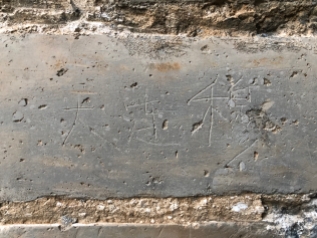The Temple of Heaven | 天壇 (12/8)
This briefer note is the second on our recent trip to China. The context for this travel will come (I hope) a few posts down the road. For now, perhaps you can just go with it. For the first post in the series, see The IU Gateway Office and Tsinghua University Art Museum (12/8).
After our group’s visit to the Tsinghua University Art Museum we ended the day with a visit to the Temple of Heaven (天壇). Wikipedia’s account (or whatever you can access) is probably sufficient for those who are curious about what the Temple of Heaven is about. In a nutshell, it is an impressive temple complex dating back to the early 1400s and was a key site for imperial sacrificial rituals. It is comprised numerous surviving buildings and beautiful grounds. For our interest as museum-types, it is a UNESCO World Heritage Site (number 881, to be exact). While it clearly attracts a significant number of visitors, visiting it (late in the day, in winter?) was certainly different from visiting the Forbidden City, where one typically becomes one tiny fish in a single vast, densely packed school of fish swimming straight through the complex from one end to another.
As earlier in the day, the companions were Jon Kay, Carrie Hertz, and Jason Jackson. At the Temple of Heaven we arrived too late in the day to enter any buildings, but we were able to stroll the grounds and see some of the buildings from the outside. Like so many monumental sites in China, one rarely has enough time to see the whole destination properly. Visiting when we did though, we really enjoyed the quiet contemplative nature of the experience. Many of those at the site were, like us, having a park visit experience as much or more than they were having a historical buildings experience. Of course, our state of reverie did not keep us from attending to the buildings, which were great. (A bit more text follows the images.)
Carrie and I, on an earlier trip’s visit to the Forbidden City, had noticed the English language signs pleading for no scratching. At the time, this had not made full sense to us, although we of course understood the impulse to protect these ancient monuments. At the Temple of Heaven, we were able wander without rushing or bumping into other people and thereby got a close look at the problem these signs work to prevent. You can see both the signs and some scratches in the images here.
We figured it out with some smart phone help, but one of the reasons that we were late in the day getting to the Temple of Heaven is that our taxi driver delivered us to the Temple of Heaven Holiday Inn (not yet a UNESCO World Heritage site), which it turns out is not exactly right by the Temple of Heaven itself. This meant that what we lost in terms of time spent at the site, we gained in terms of a walk through a not particularly touristy but elder-rich Beijing neighborhood. Posted here are some pictures for our families, friends, and other interested folks.
Thanks as always to my great travel companions. For deciding on the Temple of Heaven, thanks go especially to Carrie.




































